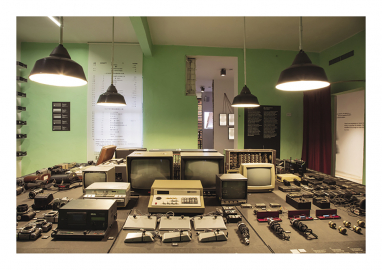“The House of Leaves". National Museum of Secret Surveillance
One among a number of historic locations that the Albanian government wishes to bring back into public consciousness, the House of Leaves is already an iconic creature sitting between a half-forgotten past and a wide-open future.
Until recently, this unobtrusive house in the middle of Tirana, Albania, served as the
headquarters of the Sigurimi, the secret service agency, operating throughout the long dictatorship of Enver Hoxha.
Its location was crucial in the geopolitics of the city for it had the “normal” appearance of a private villa.
The project of transforming the House of Leaves into a National Museum of Secret Surveillance was initiated by the Albanian Ministry of Culture in 2014 and supported by a multidisciplinary team of historians, associations of the victims, engineers and craftsmen from different countries.
The transformation of this “House” into a site of memory required delicate interventions. The derelict condition of the house is itself an integral part of its character, a kind of historic tattoo, a deeply etched condition no one can quite comprehend today.
The most telling aspect of the House, from the current point-of-view, is its multi-layered condition and its fragility.
We used two languages, Albanian and English, to bridge the gaps between citizens and visitors and between generations but also to allow people to move on their own and set their own pace.
Almost three years ago we visited the House of Leaves for the first time, when we were only allowed to look, not taking pictures, not touching and standing in front of so many locked doors. Water penetrated through the damaged roof, giving a sense of lugubrious decay as if time had stopped.
We immediately felt the urge to open every space to the public and to allow the house to speak.
We asked that nothing be removed, literally nothing, not even papers, drawings, nor any of the hundreds of pieces of technical equipment.
This was the very beginning of the Museum; just to exhibit these materials was not enough, as everyone wanted to know what had happened here. Our team spent two years studying the equipment, its provenance, the time of acquisition and use. We relied on the Archives, patiently matching mute objects with written documents. We dug into the photo and film archives, so as to be able to tell the story of the victims to whom this museum is now dedicated. We used statistics, data, graphics and texts printed on the walls, on the curtains and on many other surfaces in order to give a voice to the house and letting the voices of the people be heard.
The House of Leaves was and remains a labyrinth of rooms, with all the traces of its transformation from a Maternity Clinic to a top-secret place of surveillance; it is full of breaks, scars and unexpected places.
We treated the house with care, we applied stiches were necessary, we revealed incongruities and opened passages and we came to see how uncomfortable memories emerged.
In a country that had used labor of the incarcerated in exchange for importing surveillance devices from 18 different countries, we decided to produce everything on site, relying on the skill of people and the low cost of materials. The total cost for 33 rooms, 800mq. was 540.000 euros.
Before entering the museum, a garden covered in convallaria japonica invites people to explore the sound of the city by handling these pre-war listening devices themselves.
Visitors can gather and collect their thoughts in the backyard, sitting on two long benches,a colorful and pleasant distraction in the backyard. Walking around you soon discover that only from one point of view, marked by a read seat, do the two objects collapse into the single image of a headset, the ultimate iconic symbol of surveillance.












